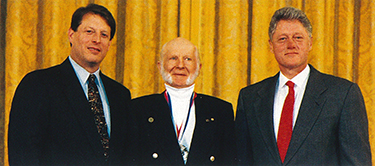UW physicist Hans Dehmelt awarded National Medal of Science

Flanked by Vice President Al Gore (left) and President Bill Clinton, UW physicist Hans Dehmelt receives his National Medal of Science.
Physics Professor Hans Dehmelt, the University’s first Nobel Prize-winning professor, received the nation’s highest scientific honor—a National Medal of Science from President Clinton Oct. 18.
Celebrated for trapping and immobilizing single subatomic particles, Dehmelt, 73, is the UW’s second National Medal of Science recipient. Medicine Professor Emeritus E. Donnall Thomas received the honor in 1990 for bone marrow transplant research done at the Fred Hutchinson Cancer Research Center.
Dehmelt joined seven other U.S. scientists also named to receive the medal at the White House ceremony. “It is a great honor to be selected as a recipient of the President’s 1995 Medal of Science,” he says. “There are few things more important to a working scientist than to be recognized in his own country.”
“This is a wonderful tribute to a great scientist,” says UW President Richard L. McCormick. “His achievements as a physicist have received the highest honors in the world, including this recognition from the nation that does the best science anywhere, most of it at its research universities. We are all very pleased for him and the University of Washington.”
Dehmelt, who joined the UW faculty in 1955 and holds the University’s Boeing Distinguished Professorship in Physics, received the medal “for his pioneering achievements in perfecting electromagnetic traps for precision studies of single ions, electrons and positrons, culminating in the measurement to unprecedented accuracy of the magnetism of the free electron.”
When referring to Dehmelt’s experimental achievements, fellow scientists employ the highest accolade a physicist can receive: the label “elegant.” Over the years, he and colleagues have continually refined their techniques for doing what many scientists once thought impossible: namely, isolating a part of the atom, an electron; holding it suspended in space; and continuously making measurements on it with revolutionary accuracy.
To date, Dehmelt and his colleagues have been the world’s first to isolate and detect an individual proton; an individual positron; small numbers of anti-protons; and a single barium ion, which, when they shined a light on it, could be seen with the naked eye as a tiny blue-white star. Further experimentation led Dehmelt’s group, in 1986, to be the first to observe a quantum leap, in which a barium ion jumped into a higher energy state—turning invisible in blue light—and then leaped back into its normal state, turning visible again.
Dehmelt traces his interest in atomic particles to his boyhood hobby of amateur radio. As a graduate student, he once explained, he became interested in trapping particles when a teacher “drew a dot on a blackboard and said, ‘Here is an electron.’
“It was simple to draw that on the blackboard,” Dehmelt continued. “Minding [physicist Werner] Heisenberg’s admonition that physics should concern itself with observables, and knowing about ion traps in radio tubes, I began to wonder, ‘How can I duplicate that localization feat (impossible, according to quantum mechanics) in the laboratory?'”
Born in Goerlitz, Germany, he studied at the Breslau Technical University in 1943-1944. Drafted into the German Army, he was taken prisoner by American forces in 1945 and spent a year as a prisoner of war. He later studied at the Georg August Universität in Göttingen, from which he received a doctorate in 1950. Before coming to Seattle, he held postdoctoral appointments at Göttingen and at Duke University. At the UW, he attained the rank of full professor in 1961, the same year in which he became a naturalized U.S. citizen.
In addition to the Nobel Prize in physics, which he shared with physicists Wolfgang Paul and Norman F. Ramsey, Dehmelt has received many honors, including the Rumford Prize (1985) from the American Academy of Arts and Sciences and an honorary doctorate from the Universität Heidelberg (1986). He was elected to the National Academy of Sciences in 1978.
Authorized by Congress in 1959, more than 320 National Medals of Science have been awarded since President Kennedy named the first recipient in 1962.